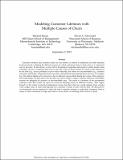| dc.contributor.author | Braun, Michael | |
| dc.contributor.author | Schweidel, David A. | |
| dc.date.accessioned | 2012-11-13T15:40:35Z | |
| dc.date.available | 2012-11-13T15:40:35Z | |
| dc.date.issued | 2011-08 | |
| dc.date.submitted | 2010-09 | |
| dc.identifier.uri | http://hdl.handle.net/1721.1/74625 | |
| dc.description.abstract | Customer retention and customer churn are key metrics of interest to marketers, but little attention has been placed on linking the different reasons for which customers churn to their value to a contractual service provider. In this paper, we put forth a hierarchical competing-risk model to jointly model when customers choose to terminate their service and why. Some of these reasons for churn can be influenced by the firm (e.g., service problems or price–value trade-offs), but others are uncontrollable (e.g., customer relocation and death). Using this framework, we demonstrate that the impact of a firm's efforts to reduce customer churn for controllable reasons is mitigated by the prevalence of uncontrollable ones, resulting in a “damper effect” on the return from a firm's retention marketing efforts. We use data from a provider of land-based telecommunication services to demonstrate how the competing-risk model can be used to derive a measure of the incremental customer value that a firm can expect to accrue through its efforts to delay churn, taking this damper effect into account. In addition to varying across customers based on geodemographic information, the magnitude of the damper effect depends on a customer's tenure to date. We discuss how our framework can be used to tailor the firm's retention strategy to individual customers, both in terms of which customers to target and when retention efforts should be deployed. | en_US |
| dc.language.iso | en_US | |
| dc.publisher | Institute for Operations Research and the Management Sciences (INFORMS) | en_US |
| dc.relation.isversionof | http://dx.doi.org/ 10.1287/mksc.1110.0665 | en_US |
| dc.rights | Creative Commons Attribution-Noncommercial-Share Alike 3.0 | en_US |
| dc.rights.uri | http://creativecommons.org/licenses/by-nc-sa/3.0/ | en_US |
| dc.source | SSRN | en_US |
| dc.title | Modeling Customer Lifetimes with Multiple Causes of Churn | en_US |
| dc.type | Article | en_US |
| dc.identifier.citation | Braun, M., and D. A. Schweidel. “Modeling Customer Lifetimes with Multiple Causes of Churn.” Marketing Science 30.5 (2011): 881–902. | en_US |
| dc.contributor.department | Sloan School of Management | en_US |
| dc.contributor.mitauthor | Braun, Michael | |
| dc.relation.journal | Marketing Science | en_US |
| dc.eprint.version | Author's final manuscript | en_US |
| dc.type.uri | http://purl.org/eprint/type/JournalArticle | en_US |
| eprint.status | http://purl.org/eprint/status/PeerReviewed | en_US |
| dspace.orderedauthors | Braun, M.; Schweidel, D. A. | en |
| mit.license | OPEN_ACCESS_POLICY | en_US |
| mit.metadata.status | Complete | |
